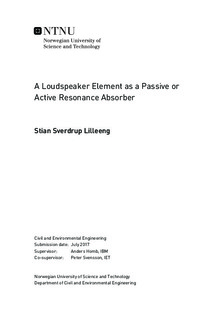A Loudspeaker Element as a Passive or Active Resonance Absorber
Abstract
Absorbing low frequent sound is a challenge, but earlier studies, (Rivet, 2017), (R. Boulandet, 2014) and (Lissek et al., 2011), have shown that a loudspeaker can function well as an absorber with a broader frequency spectre than conventional resonance absorbers. It is claimed that the mechanical properties of the loudspeaker element, which is what makes it to a resonance absorber, can be cancelled by using the right feedback in an active chain. One of the methods, described in (Lissek et al., 2011), shows remarkable results using particle velocity and pressure in an analogue feedback circuit. This method is in this thesis further investigated together with the absorption capabilities of a standard loudspeaker as a semi-active or passive absorber, which means either connected to an amplifier or not.
The thesis firstly presents the theory needed to understand how a loudspeaker can function as an absorber. Further on several measurements are performed; finding the loudspeaker parameters, adjusting the impedance by connecting different resistances to the terminal of the loudspeaker element, adjusting the active system to achieve optimal absorption and finding the effective absorption area of an ordinary loudspeaker in a reverberant room.
An ordinary loudspeaker was found to have high absorption around its resonance frequency. An optimal shunt resistor value could be calculated by the loudspeaker element parameters, and by connecting the optimal shunt resistor, the absorption factor was measured to 1 at the resonance frequency. It is though some loudspeaker elements with parameters so that the optimal resistor value is negative. Those are not recommended to use as active absorbers, but if the negative value is low, they will be good passive absorbers. Overall, the result shows that a traditional loudspeaker has some affection to the acoustical properties of a room.
The active feedback system needs equipment where the sensitivity is not frequency dependent and the phase is unaffected for the frequency range of interest. It does also seem like the parameters of the loudspeaker element must be carefully chosen to get good results. The results achieved, by using two different loudspeaker elements, indicates that it potentially might work, but was with the given loudspeaker elements far from as good as the results achieved by a previous study (Lissek et al., 2011). Suggestions for optimal loudspeaker parameters are given.
